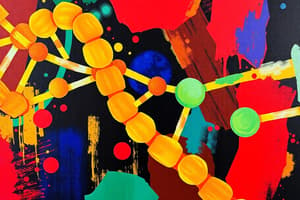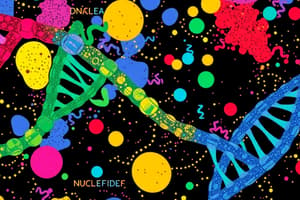Podcast
Questions and Answers
Which component is NOT consistently present in a nucleotide?
Which component is NOT consistently present in a nucleotide?
- Amino acid (correct)
- Pentose sugar
- Nitrogenous base
- Phosphate group
How does the structure of pyrimidines differ from purines?
How does the structure of pyrimidines differ from purines?
- Pyrimidines contain a 9-atom ring, while purines contain a 6-atom ring.
- Pyrimidines contain nitrogen, while purines do not contain nitrogen.
- Pyrimidines have a single-ring structure, while purines have a double-ring structure. (correct)
- Pyrimidines have a double-ring structure, while purines have a single-ring structure.
Which of the following nitrogenous bases is a purine?
Which of the following nitrogenous bases is a purine?
- Adenine (correct)
- Thymine
- Cytosine
- Uracil
What characterizes the structure of both purines and pyrimidines?
What characterizes the structure of both purines and pyrimidines?
What distinguishes ribose from deoxyribose?
What distinguishes ribose from deoxyribose?
What type of bond links a sugar to a nitrogenous base in a nucleotide?
What type of bond links a sugar to a nitrogenous base in a nucleotide?
What is the name of the bond that links a phosphate group to the sugar molecule in a nucleotide?
What is the name of the bond that links a phosphate group to the sugar molecule in a nucleotide?
Which term refers to a nucleoside with one phosphate group attached?
Which term refers to a nucleoside with one phosphate group attached?
Which component is exclusive to DNA, not found in RNA?
Which component is exclusive to DNA, not found in RNA?
What is the primary function of nucleotides beyond their role as building blocks for nucleic acids?
What is the primary function of nucleotides beyond their role as building blocks for nucleic acids?
What role do nucleotides, or their derivatives, play as coenzymes?
What role do nucleotides, or their derivatives, play as coenzymes?
What is the function of purinergic receptors in intercellular communication?
What is the function of purinergic receptors in intercellular communication?
Where does the synthesis of nucleotides primarily occur in the human body?
Where does the synthesis of nucleotides primarily occur in the human body?
What is the role of PRPP in nucleotide metabolism?
What is the role of PRPP in nucleotide metabolism?
What is the 'salvage pathway' in the context of nucleotide metabolism?
What is the 'salvage pathway' in the context of nucleotide metabolism?
Which metabolic process does inhibiting the synthesis of nucleotides affect, making it a target for cancer drugs?
Which metabolic process does inhibiting the synthesis of nucleotides affect, making it a target for cancer drugs?
What becomes of purines during degradation?
What becomes of purines during degradation?
What is the ultimate consequence of inhibiting IMP dehydrogenase?
What is the ultimate consequence of inhibiting IMP dehydrogenase?
Which enzyme type directly converts nucleosides into nucleoside monophosphates?
Which enzyme type directly converts nucleosides into nucleoside monophosphates?
What is the role of the enzyme hypoxanthine-guanine phosphoribosyltransferase (HGPRT) in nucleotide metabolism?
What is the role of the enzyme hypoxanthine-guanine phosphoribosyltransferase (HGPRT) in nucleotide metabolism?
What results from a genetic defect causing inactivation of hypoxanthine-guanine phosphoribosyltransferase (HGPRT)?
What results from a genetic defect causing inactivation of hypoxanthine-guanine phosphoribosyltransferase (HGPRT)?
Under normal conditions, can humans interconvert ATP and GTP directly?
Under normal conditions, can humans interconvert ATP and GTP directly?
What enzyme is activated by increased levels of GMP, which contributes to the balancing the levels of molecules?
What enzyme is activated by increased levels of GMP, which contributes to the balancing the levels of molecules?
What role does the enzyme ribonucleotide reductase (RNR) play in DNA synthesis?
What role does the enzyme ribonucleotide reductase (RNR) play in DNA synthesis?
What molecule provides the methyl group needed to convert dUMP to dTMP, a step specific to DNA synthesis?
What molecule provides the methyl group needed to convert dUMP to dTMP, a step specific to DNA synthesis?
What key enzyme is inhibited by fluorouracil in the context of cancer therapy?
What key enzyme is inhibited by fluorouracil in the context of cancer therapy?
How does Gemcitabine work to stop cancerous cell devision?
How does Gemcitabine work to stop cancerous cell devision?
Which of the following statements is true about RNA degradation in comparison to DNA?
Which of the following statements is true about RNA degradation in comparison to DNA?
What is the function of nucleases?
What is the function of nucleases?
What is the product of purine base degradation?
What is the product of purine base degradation?
What enzyme is inhibited by Allopurinol?
What enzyme is inhibited by Allopurinol?
What is the approximate size of the human genome?
What is the approximate size of the human genome?
What percentage of the human genome is considered unique sequences as opposed to repetitive?
What percentage of the human genome is considered unique sequences as opposed to repetitive?
Which is a characteristic of non-transposonic DNA?
Which is a characteristic of non-transposonic DNA?
From the part of the gene that is transcribed, what percentage is then translated?
From the part of the gene that is transcribed, what percentage is then translated?
What proportion of the human genome corresponds to protein-coding genes?
What proportion of the human genome corresponds to protein-coding genes?
Which structural feature is an attribute of DNA?
Which structural feature is an attribute of DNA?
What supports the great stability of DNA?
What supports the great stability of DNA?
Why DNA molecules can form quadruple structure easily and more frequently?
Why DNA molecules can form quadruple structure easily and more frequently?
Which of the following is a function of DNA methylation?
Which of the following is a function of DNA methylation?
Flashcards
Nucleotide's Structure
Nucleotide's Structure
The three components of a nucleotide
What are the purines?
What are the purines?
Adenine and Guanine
What are the pyrimidines?
What are the pyrimidines?
Cytosine, Uracil, and Thymine
What is a nucleoside?
What is a nucleoside?
Signup and view all the flashcards
What do glycosidases do?
What do glycosidases do?
Signup and view all the flashcards
What do kinases do?
What do kinases do?
Signup and view all the flashcards
What is ATP?
What is ATP?
Signup and view all the flashcards
What do anti-metabolites do?
What do anti-metabolites do?
Signup and view all the flashcards
What is the salvage pathway?
What is the salvage pathway?
Signup and view all the flashcards
What are nucleases?
What are nucleases?
Signup and view all the flashcards
What do exonucleases do?
What do exonucleases do?
Signup and view all the flashcards
What do endonucleases do?
What do endonucleases do?
Signup and view all the flashcards
What does Xanthine Oxidase do?
What does Xanthine Oxidase do?
Signup and view all the flashcards
What are intercalating agents?
What are intercalating agents?
Signup and view all the flashcards
What kind of damage comes from UV light?
What kind of damage comes from UV light?
Signup and view all the flashcards
What is a mutation?
What is a mutation?
Signup and view all the flashcards
What is polymorphism?
What is polymorphism?
Signup and view all the flashcards
What are somatic mutations?
What are somatic mutations?
Signup and view all the flashcards
What are germline mutations?
What are germline mutations?
Signup and view all the flashcards
What are point mutations?
What are point mutations?
Signup and view all the flashcards
What are transitions?
What are transitions?
Signup and view all the flashcards
What are transversions?
What are transversions?
Signup and view all the flashcards
What are Patogènes?
What are Patogènes?
Signup and view all the flashcards
What are Chromodòmiques?
What are Chromodòmiques?
Signup and view all the flashcards
What is 'c.'?
What is 'c.'?
Signup and view all the flashcards
What codes 'g.'?
What codes 'g.'?
Signup and view all the flashcards
What does 'n.' mean?
What does 'n.' mean?
Signup and view all the flashcards
What codes 'p.'?
What codes 'p.'?
Signup and view all the flashcards
What is SNP?
What is SNP?
Signup and view all the flashcards
What are allèliques?
What are allèliques?
Signup and view all the flashcards
What is gene transference?
What is gene transference?
Signup and view all the flashcards
What does BER do?
What does BER do?
Signup and view all the flashcards
What are the NER?
What are the NER?
Signup and view all the flashcards
What are the main goal?
What are the main goal?
Signup and view all the flashcards
What does the DNA is doing well?
What does the DNA is doing well?
Signup and view all the flashcards
Are the chance better?
Are the chance better?
Signup and view all the flashcards
What is PCR?
What is PCR?
Signup and view all the flashcards
What is FISH?
What is FISH?
Signup and view all the flashcards
What is CGH?
What is CGH?
Signup and view all the flashcards
What does make can you start?
What does make can you start?
Signup and view all the flashcards
What does one side have to do?
What does one side have to do?
Signup and view all the flashcards
Why to you have sequence like the all ones?
Why to you have sequence like the all ones?
Signup and view all the flashcards
Study Notes
- Nucleotides consist of a sugar, a nitrogenous base, and a phosphate group.
Nitrogenous Bases
- Purines and pyrimidines are the two categories of nitrogenous bases.
- Purines feature a double-ring structure with a 9-atom skeleton, including adenine and guanine.
- Pyrimidines feature a single-ring structure with a 6-atom skeleton, including cytosine, uracil, and thymine.
- Variants like caffeine exist, and both purines and pyrimidines are planar and hydrophobic.
Pentoses
- The base is attached to the sugar’s carbon 1, forming either ribose or deoxyribose.
- Ribose has an OH group on carbon 2, while deoxyribose lacks an oxygen atom at this location.
- This difference determines the type of nucleotide.
- The sugar-base combination is a nucleoside linked by a glycosidic bond, an association targeted by glucosidases.
Phosphate
-
The sugar connects to 1-3 phosphate groups via carbon 5, forming a phosphoric ester bond.
-
The molecule is a purine deoxyribonucleotide monophosphate, composed of carbon, hydrogen, oxygen, nitrogen, and phosphate.
-
Nucleotides are classified as 5'-mono/di/triphosphate nucleosides.
-
Guanilate, adenylate, and uridylate refer to monophosphate nucleotides; thymidine is exclusively linked to deoxyribose.
-
Nucleotides are monomeric units of nucleic acids like DNA and RNA.
-
They store and transport chemical energy within cells, like ATP.
-
Nucleotides function as coenzymes, serving as phosphate group donors during phosphorylation reactions.
-
Signaling transduction can initiate as switches and modulators.
-
They also facilitate intercellular communication, acting on receptors in other cells.
-
These include purinergic receptors, and mediate processes such as pain and coagulation.
-
Objectives include understanding the general structure of nucleosides and nucleotides; identifying essential nitrogenous bases; differentiating purines from pyrimidines; knowing important bonds and nomenclature; recognizing biological functions; understanding transferred groups; and grasping key concepts and molecules.
Nucleotide Metabolism
- Early cancer treatments targeted nucleotide metabolism.
- Cells synthesize nucleotides from PRPP and simple molecules (the de novo synthesis).
- Interconversions occur; nucleotides form nucleic acids and fulfill diverse roles.
- Synthesis balances degradation, turning nucleotides into nucleosides via phosphatases, yielding uric acid.
- Recycling exists, allowing resynthesis from nucleosides and bases.
- Nucleotides are mainly self-produced, different from the other molecules, other than in intestinal mucosal cells which capture them from the food
- Nucleotides are essential for many cell functions and are produced primarily via de novo synthesis, using PRPP and basic precursors, or via salvage pathways, recycling bases from RNA and DNA degradation.
- Chemotherapy drugs inhibit nucleotide synthesis, thereby preventing proliferation in cancer cells.
- Nucleotides undergo dephosphorylation to nucleosides through the action of nucleotidases.
- Nucleosides can degrade into nitrogenous bases and be reused in the salvage pathway.
- Purine degradation leads to uric acid, excreted in urine.
- Uric acid in humans stems from humans lacking the uricase enzyme, and serve as antioxidants.
- Ribose, with two phosphates, forms phosphoribosyl pyrophosphate; purines and pyrimidines have distinct synthesis pathways.
Ribonucleotide Synthesis
-
Purine rings are synthesized from amino acids, formyl groups, and CO2 all bonded to a ribose.
-
ATP hydrolysis is vital in diverse reactions: a costly synthesis linked to cytosolic synthesis, where ribose and phosphate are conserved, and amidotransferases facilitate purine ring development.
-
Many steps use ATP, making the process energetically expensive.
-
The final stage of synthesis involves monophosphate inosinic having ribose, phosphate of PRPP, and the purine base of hypoxanthine serves as precursor.
-
With AMP made from inosinic with adenylosuccinate synthetase adding aspartate with energy expenditure, while GMP is generated involving IMP dehydrogenase.
-
The IMP branching-off enables the making of adenosine or guanine monophosphate.
-
Building blocks are the most important nucleotides, with several steps necessitating ATP.
-
GMP or AMP accumulation slows down the reaction overall as they are allosteric inhibitors.
-
Essential nucleotides, trifosphates and kinases synthesize purine nucleotides from those mentioned.
Salvage Pathway
-
Nucleoside kinases convert purine nucleosides into monophosphate nucleotides, balancing nucleoside recycling and degradation.
-
There are nucleoside kinases which essential for generating nucleosides.
-
The enzyme links a guanine or adenine with PRPP in a manner that requires recognition for two structures that is inborn in nucleotide recycling, and a genetic disease that is Lesch-Nyhan in its origin.
-
By the action of adenosine mono or diphosphate and by adding phosphate, but humans don't interchange those molecules.
-
Pushes in guanine levels activate the GMP reductase in IMP-AMP.
-
When AMP levels rise, AMP desaminase turns in into inosinic then in AMP, important when doing novo.
Pyrimidines Synthesis
-
Synthesis occur by joining aminoacids and adding CO2 to ribose in cost process.
-
Synthesis occurs first as a free form over a ribose that needs to be later bound and are usually in the cytosol except is not mitochondria.
-
Base orotate needs PRPP to be converted into UMP. With aspartate giving atoms in reactions with multifunctional enzyme.
-
Liking reactions leads to orotidine, which is needed to synthesize for instance UMP in similar mechanism. Interconversion between nucleotides can lead to the creation of other nucleotides like uracil.
-
As UTP is highly bioavailable it can be used to make CTP directly, unlike adenine derivatives.
Desoxyribonucleotides Synthesis
- Forms from ribonucleic forms in reaction the is catalyzed be reductorase in the presence of NADPH.
- Reduction is greatly involved in DNA replication with several levels of regulation and inhibition when deoxirobos are exhausted.
Thymidylate Synthase
-
Enzyme using uracil, that adds methyl from tetra hydro folate. It must have a good performance in cells and good formation in the fetus through enzyme action to generate thymine derivatives.
-
Trifosfates that will work the DNA polymerase is incorporated as a phosphate and broken.
-
The different types of DNA replication process involve a succession of dNTP formation which goes from monofosphate to diphosphate and finally ends in triphosphate that is used by the polymerase, leading phosphate and pyrofosfato as result.
-
Cell metabolism with constant synthesis RNA production, which have fast recycle.
-
Those molecules are broken, which is what happens to the DNA and there is deoxirybonucleides that gets a phosphate and becomes the molecule of origin.
-
Nucleases (DNAses, RNAses) break nucleic acids and those molecules become monophosphate that loses the phosphate and becomes nucleoside.
-
Those bases is converted from purinas that it's uric and the pyrimidines are aminoacids.
-
Guanina then has catalysed by xanthine in uric production. By using allopurinol one can inhibit the development of other molecules preventing oxidation.
-
Uric high levels in humans helps prevent oxidation, other mammals degrade the moleculs.
Pharmacology
-
Purine acts frenando aminos. Like 5-fulor inhibited timidilat. With gencitabine which have normal sugar the polymerase falls because is unable to continue action with an inhibited RNR. Metotrexat synthesis timiditalis slowing and can create terato effects.
-
Students should integrate several concepts that goes from nucleotide genesis synthesis pathway to different transformations with several concepts.
-
Key steps are new pathway in different configuration or different locations.
-
Main points are different steps for several metabolism process and transformation. . DNA needs regulation points during synthesis and synthesis of ribonucleic acids from bases that leads to degradación.
-
It all is connected to some interconversion process involving many molecules.
DNA
-
Molecule is very huge, only appears over one chromosome part, it's vital function as it's genetic warehouse.
-
This molecule is composed of deoxirybonucleides with different structures and sequencings of bases so info coded can be stored.
-
Nuclesides that make bonds of phosphate and that breaks. In each section the fifth atom doesn't connect, where a three is free and that is where the sequence is written.
-
The normal human genes have 3.4 millions os base and other that are sex chromosomes only contains thousands, those differences can be genetic mutations
-
There can appear illnesses involving automosomes, and several factors of all its components. For instance the DNA can be 1% of a simple process or be extremely complicated,
-
It's measurement isn't much of matter and junked DNA might appear through several species with small or big functions, or to just accumulate
-
Structures that repeat from different structures over positions or the transposonics structures.
-
Transcribed parts, the 20% is trascribed with intergenic junk as the majority of trascribed proteins, and more structures are regulator with gene receptors.
-
This protein that's on a human can had an initiation ending where enzymes starts acting with DNA into messaging that cuts genes, it also needs a polyA portion so ribosomes can connect to the sequence.
-
Proteins are coded through regions contained introns and exons in 35% of structures. Those are contained in certain data storage that forms bank regions
-
Many things are coded in Manhattan plot and they are put depending on every thing that have the study, the genes that are in charge with protein coding.
-
Genes are ordened through DNA sections
-
Deixoribonucleides form bonds using 3 and 5 carobonos that gives DNA stability. These bounds are hydrophobic
-
Structure can save info through various positions by putting code in the four bases through the three levels of the genic.
-
Deoxiryboja can form stable and hydrophobic interactions through base positioning that is saved from different structures and base exposure levels.
-
DNA can had modification though methilation (that's done though DNA tranferase by giving groups during DNA duplication), so the methyl is added to citosine on one position to another where different proteins, transcription parts do all the changes.
-
There may be other genes in the genic transformation, with the purpose of stopping a situation without changing function with cell type transfers during cell life
-
All those methylation patters get sent to all structures.
Recombined DNA
- Genetic composition can generate transformations as DNA has several composition during replication that changes sequences of the original parts, with that part serving as template through an exchange and a generation of new structure, all made in meiosis.
Non-homologous
- Only happens in B and in Limp that contains several types of antitoxins with constant variability. Is there is a recombindation, the changes will occur in lightweight genes to those that might have contact making the cells dividing and be imune from external agents
Studying That Suits You
Use AI to generate personalized quizzes and flashcards to suit your learning preferences.





